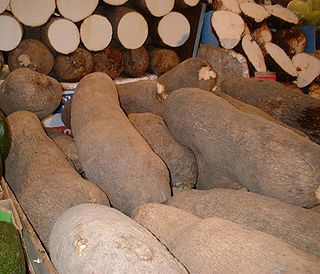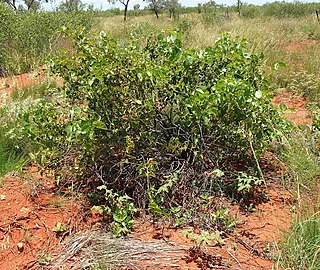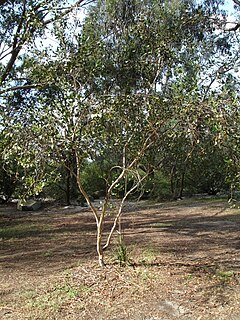
The potato is a starchy tuber of the plant Solanum tuberosum and is a root vegetable native to the Americas. The plant is a perennial in the nightshade family Solanaceae.

The Noongar are Aboriginal Australian peoples who live in the south-west corner of Western Australia, from Geraldton on the west coast to Esperance on the south coast. There are 14 different Noongar groups: Amangu, Ballardong, Yued, Kaneang, Koreng, Mineng, Njakinjaki, Njunga, Pibelmen, Pindjarup, Wadandi, Whadjuk, Wiilman and Wudjari. The Noongar people refer to their land as Noongar boodja.

The yacón is a species of perennial daisy traditionally grown in the northern and central Andes from Colombia to northern Argentina for its crisp, sweet-tasting, tuberous roots. Their texture and flavour are very similar to jícama, mainly differing in that yacón has some slightly sweet, resinous, and floral undertones to its flavour, probably due to the presence of inulin, which produces the sweet taste of the roots of elecampane, as well. Another name for yacón is Peruvian ground apple, possibly from the French name of potato, pomme de terre. The tuber is composed mostly of water and fructooligosaccharide.

Podocarpus drouynianus is a species of podocarp native to the relatively high rainfall southwestern corner of Western Australia, where it is known by the name emu berry, wild plum or native plum although it is not a true plum. The Noongar name for the plant is koolah.

Santalum acuminatum, the desert quandong, is a hemiparasitic plant in the sandalwood family, Santalaceae, which is widely dispersed throughout the central deserts and southern areas of Australia. The species, especially its edible fruit, is also commonly referred to as quandong or native peach. The use of the fruit as an exotic flavouring, one of the best known bush tucker, has led to the attempted domestication of the species.

Apios americana, sometimes called the American groundnut, potato bean, hopniss, Indian potato, hodoimo, America-hodoimo, cinnamon vine, or groundnut is a perennial vine that bears edible beans and large edible tubers.

Agonis flexuosa is a species of tree that grows in the south west of Western Australia. It is easily the most common of the Agonis species, and is one of the most recognisable trees of Western Australia, being commonly grown in parks and on road verges in Perth.

Ravensthorpe is a town 541 km south-east of Perth and 40 km inland from the south coast of Western Australia. It is the seat of government of the Shire of Ravensthorpe. At the 2006 census, Ravensthorpe had a population of 438.

Acacia cyclops, commonly known as coastal wattle, cyclops wattle, one-eyed wattle, red-eyed wattle, redwreath acacia, western coastal wattle, rooikrans, rooikrans acacia, is a coastal shrub or small tree in the family Fabaceae. Native to Australia, it is distributed along the west coast of Western Australia as far north as Leeman, and along the south coast into South Australia. The Noongar peoples of Western Australia know the plant as wilyawa or woolya wah.

Acacia saligna, commonly known by various names including coojong, golden wreath wattle, orange wattle, blue-leafed wattle, Western Australian golden wattle, and, in Africa, Port Jackson willow, is a small tree in the family Fabaceae. Native to Australia, it is widely distributed throughout the south west corner of Western Australia, extending north as far as the Murchison River, and east to Israelite Bay. The Noongar peoples know the tree as Cujong.

Pachyrhizus erosus, commonly known as jícamaMexican turnip, is the name of a native Mexican vine, although the name most commonly refers to the plant's edible tuberous root. Jícama is a species in the Pachyrhizus erosus in the pea family. (Fabaceae). Pachyrhizus tuberosus and Pachyrhizus ahipa are the other two cultivated species. The naming of this group of edible plants can sometimes be confusing, with much overlap of similar or the same common names.

Yam is the common name for some plant species in the genus Dioscorea that form edible tubers. Yams are perennial herbaceous vines cultivated for the consumption of their starchy tubers in many temperate and tropical regions, especially in West Africa, South America and the Caribbean, Asia, and Oceania. The tubers themselves, also called "yams", come in a variety of forms owing to numerous cultivars and related species.

Santalum spicatum, the Australian sandalwood, also Waang and other names (Noongar) and Dutjahn (Martu), is a tree native to semi-arid areas at the edge of Southwest Australia, in the state of Western Australia. It is also found in South Australia, where it is protected and listed as a vulnerable species. It is traded as sandalwood, and its sandalwood oil has been used as an aromatic and a food source over history. S. spicatum is one of four Santalum species occurring in Australia.

Melaleuca nesophila, commonly known as showy honey-myrtle, mindiyed or pink melaleuca, is a plant in the myrtle family, Myrtaceae and is endemic to an area near Albany in Western Australia. The Noongar name for the plant is mindiyet. Hardy and adaptable, with a dense crown of leaves and prolific heads of pink or purple flowers in late spring and summer, it is one of the most commonly cultivated melaleuca shrubs.

Ipomoea costata, commonly known as rock morning glory, is an Australian native plant. It is found in northern Australia, from Western Australia, through the Northern Territory, to Queensland. Its tubers provide a form of bush tucker to some Aboriginal peoples, known as bush potato, or, karnti.

The Dryandra Woodland is a national park in Western Australia within the Shires of Cuballing, Williams and Wandering, about 164 kilometres south-east of Perth and 22 kilometres north-west of the town of Narrogin. It is a complex of 17 distinct blocks managed by the Western Australian Department of Parks and Wildlife and spread over approximately 50 kilometres separated by areas of agricultural land. The area is considered to be one of the state's major conservation areas, and although it is far from pristine due to its history of logging operations, a number of species of threatened fauna are rebuilding populations through the removal of introduced predators such as foxes and feral cats.

Eucalyptus platypus, also known as moort or maalok, is a species of mallee or marlock that is endemic to the southwest of Western Australia. It has smooth bark, broadly elliptical to more or less round adult leaves, flower buds in groups of nine on a broad, flattened peduncle, usually creamy white flowers and conical, down-turned fruit.

Chaerophyllum bulbosum is a species of flowering plant from the carrot family and known by several common names, including turnip-rooted chervil, tuberous-rooted chervil, bulbous chervil, and parsnip chervil. It is native to Europe and Western Asia. It was a popular vegetable in the 19th century.

Kwongan is plant community found in south-western Western Australia. The name is a Bibbelmun (Noongar) Aboriginal term of wide geographical use defined by Beard (1976) as
...a type of country ...[that is] sandy and is open without timber-sized trees but with a scrubby vegetation. It consists of plains in an Australian sense of open country rather than in a strict sense of flat country. ... there are two principal plant formations in the kwongan, scrub heath and broombush thicket ... both ... are sclerophyll shrublands and possess a certain unity when contrasted with woodland and forest or steppe and succulent steppe communities.
Platysace maxwellii, commonly known as native potato or karno, is a shrub that is endemic to Western Australia. The Noongar names for the plant are karno and yook, with the latter name also referring to the closely related species Platysace deflexa which grows further south.



















